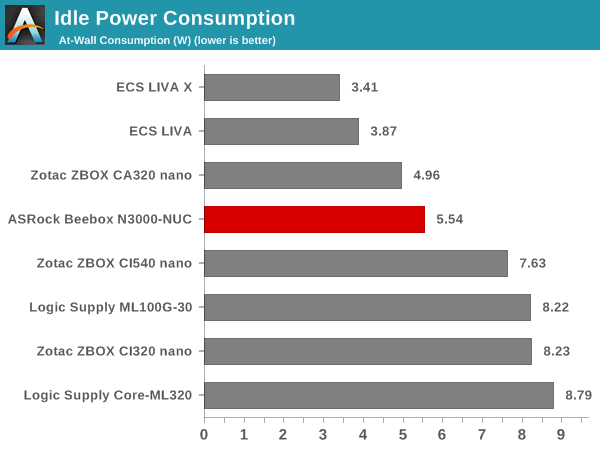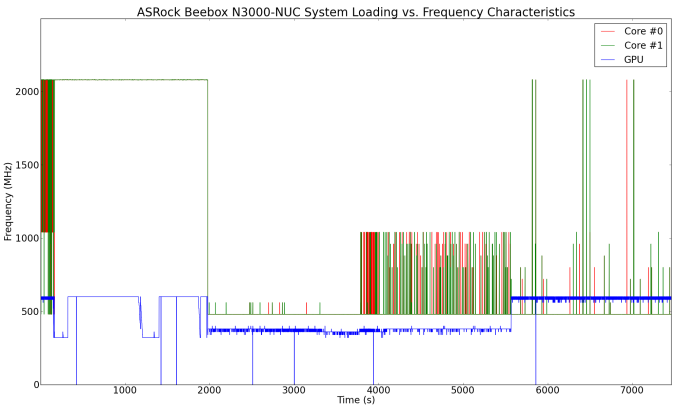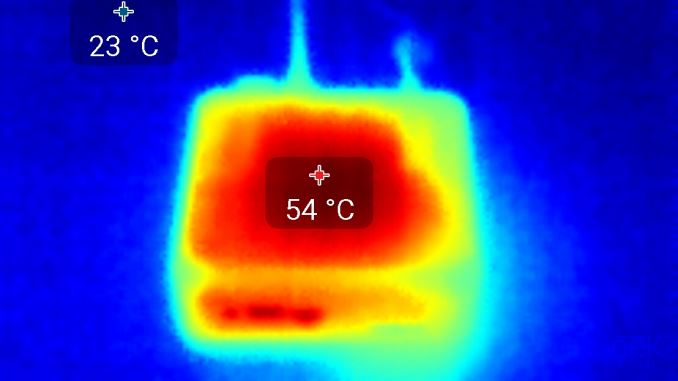ASRock Beebox Review: A Fanless Braswell UCFF PC
by Ganesh T S on July 14, 2015 8:00 AM ESTPower Consumption and Thermal Performance
The power consumption at the wall was measured with a 1080p display being driven through the HDMI port. In the graphs below, we compare the idle and load power of the ASRock Beebox N3000-NUC with other low power PCs evaluated before. For load power consumption, we ran Furmark 1.12.0 and Prime95 v27.9 together. In our initial run, the idle power was quite hight (more than 7 W). However, the installation of the Intel iRMT driver (Ready Mode Technology) was necessary to make the system behave well with the default BIOS settings. We repeated our tests after installing iRMT and recorded the numbers below.


The load power consumption is impressive, but it must be remembered that the SoC has only two cores and a TDP of 4W. The idle power consumption is reasonable, once the replaceable RAM and internal storage are considered.
The various clocks in the system as well as the temperatures within the unit are presented below. We start with the system at idle, followed by 30 minutes of pure CPU loading. This is followed by another 30 minutes of both CPU and GPU being loaded simultaneously. After this, the CPU load was removed, allowing the GPU to be loaded alone for another 30 minutes.
The Celeron N3000 manages to stay at the maximum turbo frequency of 2.08 GHz throughout the pure CPU stress segment. As soon as the GPU starts getting stressed alongside, the CPU cores drop down to around 500 MHz and the GPU starts clocking between 360 MHz and 400 MHz. Removing the CPU stress aspect allows the core to ramp up to 1.04 GHz as necessary to keep Furmark going along smoothly. It can be said that all these frequencies are managed to ensure that the TDP limits are obeyed. Sustained operation at the maximum turbo frequency for pure CPU loading indicates that the system's thermal design doesn't hobble the performance of the unit in any way.
Looking at the internal temperature during the loading process, we find that the thermal solution is able to keep the SoC well below the maximum junction temperature of 90 C. Even under heavy GPU loading (which seems to heat up the SoC faster than pure CPU loading), the temperature stabilizes around 84 C.
Another important aspect to keep note of while evaluating fanless PCs is the chassis temperature. Using Seek Thermal's thermal imager, we observed the chassis temperature after the CPU package temperature reached the steady state value in the above graph.
Even under extreme stress, the chassis temperature didn't cross 60 C. As FanlessTech notes, the thermal solution is very similar to that of the Zotac ZBOX C-series - a thermal pad on a small heat sink. However, this crude solution seems to be good enough for the Celeron N3000 - chassis temperatures remain in the safe territory, there is no thermal throttling and the SoC temperature remains well below TJmax.


















45 Comments
View All Comments
losergamer04 - Tuesday, July 14, 2015 - link
The lack of bitstream audio is surprising given the box includes an IR remote.Flunk - Tuesday, July 14, 2015 - link
Very few people actually use home theater systems and those who do can probably afford to spend a bit more on a media computer. I can see why they wouldn't bother on such a low-end system.waldojim42 - Tuesday, July 14, 2015 - link
Just because people can spend more, doesn't mean they want to. A $220 media PC, with bitstream audio that will bolt on to the back of the TV sounds quite nice. Especially if it works well in that role.owarchild - Tuesday, July 14, 2015 - link
Agreed! The Raspberry Pi2 and the Celeron 2955U Chromebox are widely used for inexpensive HTPCs by the Kodi community. Braswell could become a nice alternative featuring HEVC support.chrnochime - Tuesday, July 14, 2015 - link
Or just go buy the NUC version that does support DTS-MA/HDcjs150 - Tuesday, July 14, 2015 - link
Flunk: It is not about whether it is low end, but whether it does what is needed. I have a home theatre system and want something like Beebox. What I need is something that plays ripped Blu-rays perfectly, correctly delivers the sound to the AV receiver, can deal with Netflixs, Amazon Prime, Youtube in HD and light web browsing yet at the same time sips power so that it is on 24/7.Gadgety - Tuesday, July 14, 2015 - link
@cjs150 Yep, me too.Cinnabuns - Tuesday, July 14, 2015 - link
Me three.GTVic - Tuesday, July 14, 2015 - link
Everything has a purpose. If you purchase a Vitamix it also will do a spectacular job of not delivering bitstream audio to your HTS.kmmatney - Tuesday, July 14, 2015 - link
Can an iPad with Airplay do all that? Or an iPad with a $15 HDMI adapter? Seems like it would be much better than any HTPC for everything you mentioned. I use Air video for watching movies on our iPads (best $3 I ever spent) but haven't tried connecting it to the TV. You can buy used iPads for $200, and that's a much better deal, as you can do a lot more with it, besides the typical HTPC functions. Also, don't modern "Smart" TVs do everything you mentioned?